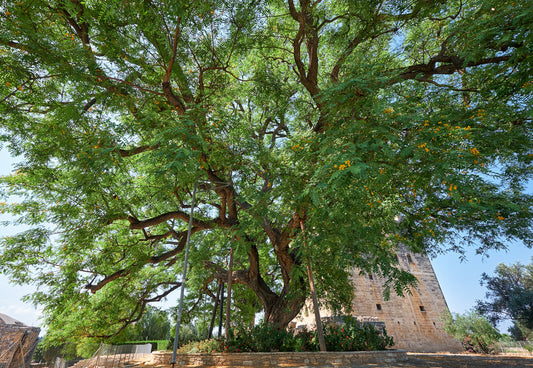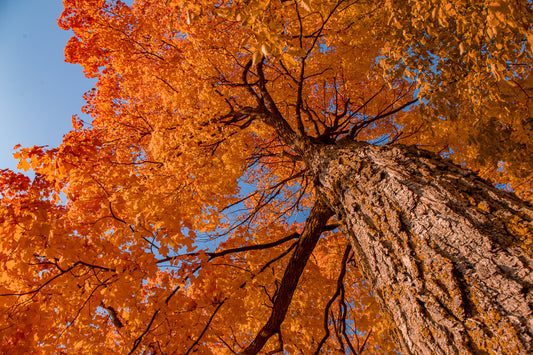The oak might be among the first images that come to mind when you think of the word “tree”. Many designers and architects embraced oak throughout history. Known for its durability, longevity, and resistance to wear, oak became a favored hardwood choice for designers and architects who sought to craft pieces of enduring quality.
Between the natural and the man-made, the oak tree serves as a fascinating link, carrying immense significance across cultures and historical narratives. The majestic oak, revered in Celtic mythology and deemed sacred, represented strength, wisdom, and spiritual connection, while Greek mythology associated it with Zeus, the king of gods. These cultural echoes reach far and wide, carrying a shared perception of the oak as a symbol of enduring strength and nobility.
In the pages of history, specific oak trees have attained almost legendary status. The Major Oak of Sherwood Forest, believed to be the secret shelter of the legendary Robin Hood, and the Emancipation Oak in Virginia, under whose shade the first Southern reading of President Lincoln's Emancipation Proclamation occurred, serve as poignant reminders of the tree's intertwining with human stories.
This rich cultural and historical narrative associated with the oak tree beautifully dovetails with its use in design and architecture. Designers' fondness for oak reflects not just its durability and longevity, but also its symbolic resonance of strength and endurance. Thus, it forms a metaphorical bridge between our ancestral reverence for the natural world and our modern aspiration for art, design, and functionality.
Perhaps the best example of using oak in design is Josef Albers' iconic "Nesting Tables", a series of four different-sized tables designed to fit within one another, much like a Russian nesting doll. They were designed in 1926 during his tenure at the Bauhaus and exemplify the Bauhaus school's guiding principles of simplicity, functionality, and unity of art and design. Crafted to resonate with the ethos of practicality, the tables reflected the need for space efficiency, a major consideration given the increasingly urbanized living environments of the 20th century.

Josef Albers' "Nesting Tables"
The use of oak wood for the tables' frames was a strategic choice. Oak's strength and durability were ideal for supporting the structure, ensuring that the design's elegance did not compromise its functionality.
In a nod to the Bauhaus school's commitment to modernity, Albers contrasted the traditional oak frames with tabletops made from either glass or acrylic, materials that were relatively new and innovative at the time. This fusion of traditional and modern materials was very much in line with the Bauhaus style, demonstrating a synthesis of age-old crafting techniques with emerging industrial design trends.
The oak tree
The oak tree is an emblem of strength, resilience, and longevity. Noted for its robust size and majestic presence, it belongs to the genus Quercus, a group that comprises nearly 600 species that are native to various regions across the Northern Hemisphere. These species range from deciduous trees in cooler climates to evergreen types in warmer areas, reflecting the oak's wide adaptability.
Oak trees can grow exceptionally large, with many species reaching heights of 60 to 100 feet, and some, such as the White Oak, growing even taller, with maximum heights of up to 150 feet. These heights are accompanied by expansive canopies that can stretch nearly as wide as the tree is tall, providing ample shade and creating a commanding presence in the landscape.
The lifespan of an oak tree is equally impressive. On average, oaks can live for several hundred years, with many reaching an age of over 500 years. Some exceptional specimens have been known to have lived for over a thousand years, truly embodying the oak's reputation for longevity.
Despite their impressive size and lifespan, oak trees start their life as small acorns. The journey from acorn to mature tree is a lengthy one. After germination, the oak tree's growth is slow, typically taking around 20 to 30 years to reach full maturity.
Each species exhibits distinct characteristics, with variations in leaf shape, bark texture, and acorn type, adding to the complexity and diversity of the oak family. The White Oak, Red Oak, and Black Oak are among the more commonly recognized species, each valued for their unique attributes. Regardless of their species, there are several common characteristics that make oaks easily recognizable and distinct.
One of the most distinguishing features of an oak tree is its leaves. Generally, oak leaves exhibit a lobed form with uneven edges, a quality that is consistent across the oak genus. However, the shape, size, and number of these lobes can vary significantly across species. For instance, leaves of the White Oak are characterized by rounded lobes, setting them apart from the pointed lobes found on the Red Oak.

An example of an oak leaf, Photo by Azimbek Assarov on Unsplash
Bark is another key characteristic that varies among oak species, ranging in color from light gray to dark brown. While some oaks display smooth bark in their youth, it often becomes ridged and furrowed as the tree ages. Some species, like the Black Oak, are known for their deeply ridged, dark-colored bark, in stark contrast to the White Oak, whose bark appears light gray, often giving a white effect.
The acorns, the fruit of the oak tree, provide another distinguishing characteristic. Acorns vary widely in size, shape, and color, and their maturation time can range from one to two years, depending on the species. The White Oak acorns mature in a single season, while both Red Oak and Black Oak have acorns that take two seasons to mature.

Photo by Christian Bass on Unsplash
The size and shape of an oak tree can also exhibit significant variation across species. Some oaks retain a relatively small and shrubby stature, while others flourish into large, majestic trees. The breadth of the crown can also differ; it may be wide spreading, as seen in the White Oak, or appear rounded and compact, as observed in some other species.
In addition to its aesthetic appeal, the oak tree has several functional characteristics that contribute to its popularity as a design material. Its hardwood is renowned for its exceptional strength and hardness, making it highly resistant to wear and tear. The wood also has an attractive grain pattern and takes well to a variety of finishes, allowing it to be used in a wide range of styles and aesthetics.
Furthermore, oak wood's natural tannins offer a high degree of resistance against fungi and insects, enhancing its durability and lifespan. It's also relatively easy to work with, despite its hardness, and it can be cut, shaped, and joined with relative ease, making it a favorite among craftsmen and designers.
But to really appreciate the tree, we need to more away from the world of design and enter the world of ecology. While majestic as an individual, the oak truly shines as a community – as a forest.

Photo by Chris Bair on Unsplash
Conclusion
The enduring allure of oak, from ancient woodworkers to the innovative Bauhaus movement and to modern day, remains undiminished. These trees not only provide the sturdy foundations for masterpieces of design but also play a crucial part in forest ecosystems. They offer refuge, nourishment, and security to countless species, demonstrating their critical role in biodiversity. Yet, the future of oaks is inseparable from our actions. From acorn to furniture, the story of the oak is an emblem of our intertwined history with nature, of the time-honored bond between human craftsmanship and the world's remarkable biodiversity. To celebrate the oak’s ecological roles and cultural heritage, we need to treat oak furniture with the respect it deserves.
Article by: Andrei Mihail, see more about the author here
References




